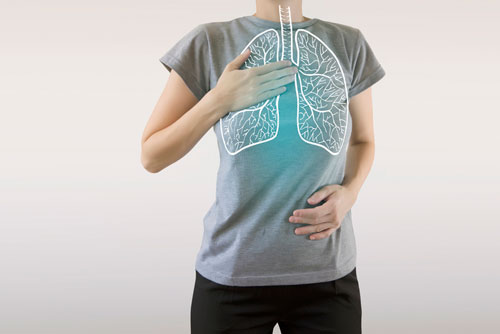The coronavirus pandemic has us all thinking more about our lungs.
What many of us don’t know is that it’s easy to damage your respiratory system without knowing it. Potential lung dangers lurk where you’d least expect it.
Here are six ways you may be unknowingly hurting your lungs.
Avoid These Stealth Respiratory Dangers During the Pandemic
- Vacuuming and sweeping. Running a vacuum along the floor or sweeping kicks up dust. Many people have dust allergies which can affect your lungs and make you miserable. Dr. George Friedman-Jimenez is assistant professor at New York University School of Medicine. He recommends using a damp mop rather than dry sweeping. If you vacuum, make sure your unit has a HEPA filter. It will reduce harmful small particles that you can inhale.
- Being sedentary. Your lungs need exercise to stay in good shape. When you do aerobic exercise such as jogging, walking, swimming, or bicycling, your body needs more oxygen. So your lungs work harder. The muscles between your ribs expand and contract more forcefully and your air sacs work faster to pull in oxygen and expel carbon dioxide. Your entire respiratory system gets stronger. This makes you better able to fight off lung infections. And you’ll recover faster if you do get them.[1]
- Eating cold cuts. Processed meats such as cold cuts and hot dogs contain preservatives called nitrates. A study published in the European Respiratory Journal found that nitrates raise the risk of hospital admissions due to chronic obstructive pulmonary disease (COPD).[2]
Regular, unprocessed meats usually don’t contain nitrates. When buying packaged meats, be sure to check the label to make sure they are nitrate-free. - Breathing paint fumes. Always make sure you have fresh air circulating when you paint walls or furniture in an interior space. Paint gives off chemicals called volatile organic compounds (VOCs).[3]
VOCs can irritate your lungs, and cause tissue damage and serious lung diseases. Some VOCs can make existing breathing disorders like asthma and COPD worse.[4]
It’s best to paint items outside if possible. When painting interior walls, put a fan in the window. You can also get a respirator mask specifically made for painting for around $40.
Another option is use a “low-VOC” paint. These are paints formulated to emit less fumes. - Inhaling radon gas. This naturally occurring radioactive gas gets into homes through the soil and leaches through cracks in the foundation. One out of 15 homes in the U.S. has dangerous levels of radon gas, according to the U.S. Environmental Protection Agency.
About 21,000 lung cancer deaths a year are caused by radon. It’s the second leading cause of lung cancer after smoking.[5]
Radon gas is invisible and odorless. But you can check for it in your home with a do-it-yourself test or a digital detector. These are available from home repair stores and online retailers. Test kits cost as little as $14.95. Electronic detectors will run you between $130 and $200.
If your home has elevated levels of radon, you can have a radon mitigation system installed. It consists of a fan, vent pipe, and properly sealed cracks. There are professionals who do this work that you can find online. - Overdosing on bleach. Strong disinfectants such as bleach, ammonia, and chlorine exacerbate lung diseases including COPD and asthma. And they can cause asthma in people who haven’t had it before.
Dr. George Friedman-Jimenez is assistant professor at New York University School of Medicine. He says you can usually do without harsh cleaning agents.
People assume regular cleaning requires a house to be disinfected, “but in reality, soap and water, or even just water, remove a great majority of bacteria and viruses,” says Dr. Friedman-Jimenez.[6]
If you want to disinfect an area because a family member has flu or coronavirus, he recommends a solution no stronger than one-part bleach to ten-parts water. “Most people use too strong a solution,” Dr. Friedman-Jimenez said.
With coronavirus circulating, it’s more important than ever to keep your lungs healthy. Make sure that you’re not your respiratory system’s own worst enemy.
Editor’s Note: Discover the single best supplement for stronger immunity… The fruit extract that helps 93% of people with respiratory viruses get better in just two days… The germ hotspot that most of us forget to sanitize. Find all this and more in Independent Healing’s Coronavirus Pandemic Guide. Go HERE.
Related Articles
Coronavirus: Stay in the ‘Goldilocks Zone’ for Better Health
Coronavirus Stress: 5 Ways to Keep Calm and Carry On
9 Coronavirus Symptoms You Should Watch For
Like this Article? Forward this article here or Share on Facebook.
[1]https://www.healthline.com/health/understanding-idiopathic-pulmonary-fibrosis/ways-to-keep-your-lungs-healthy-and-whole#3
[2]https://erj.ersjournals.com/content/40/3
[3]https://www.epa.gov/indoor-air-quality-iaq/what-are-volatile-organic-compounds-vocs
[4]https://blog.lptmedical.com/volatile-organic-compounds-and-your-lungs
[5]https://www.lung.org/clean-air/at-home/indoor-air-pollutants/radon
[6]https://www.thehealthy.com/respiratory/damage-lungs

